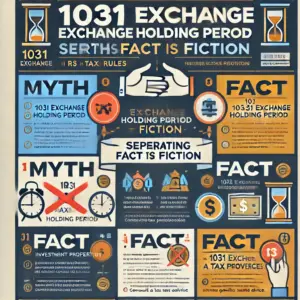The 1031 exchange, named after Section 1031 of the Internal Revenue Code, allows real estate investors to defer capital gains taxes when they exchange one investment property for another. While this strategy is widely used, one of the most misunderstood aspects of a 1031 exchange is the holding period requirement—how long an investor must hold a property before and after the exchange for it to qualify.

Many investors believe there are clear-cut rules regarding the holding period, but in reality, the IRS has not explicitly defined a minimum timeframe. Instead, the qualification depends on intent, documentation, and past IRS rulings. In this article, we’ll debunk some of the most common myths surrounding the 1031 exchange holding period and provide clarity on how investors can stay compliant.
Myth 1: The IRS Requires a Specific Holding Period (e.g., Two Years) for a Property to Qualify
The truth is that no fixed holding period exists in the tax code for 1031 exchanges. Many investors assume that they must hold a property for a specific amount of time—often two years—before they can use it in a 1031 exchange. However, the IRS does not set a hard-and-fast rule about how long a property must be held before it qualifies for tax-deferred treatment.
Instead, the IRS looks at the intent of the investor when purchasing and holding the property. If the property was acquired with the intention of being used as an investment or for business purposes, it can qualify for a 1031 exchange. However, if it was purchased with the intention of being flipped for a quick profit, the IRS may argue that it was not an investment and thus does not qualify.
In Revenue Procedure 2008-16, the IRS provided a safe harbor for properties used as vacation homes or rental properties, stating that they should be held for at least 24 months before a 1031 exchange to minimize audit risk. Other tax cases suggest that a one-year holding period is often sufficient for proving investment intent, particularly because the IRS looks at whether a property is reported on at least one tax return.
That said, while no law mandates a minimum holding period, many tax professionals recommend holding a property for at least one or two tax years to demonstrate that it was used as an investment.
Myth 2: You Can Immediately Sell a Replacement Property After a 1031 Exchange Without Consequences
The truth is that selling too soon after an exchange can raise red flags with the IRS. Some investors mistakenly believe that once they complete a 1031 exchange, they are free to sell the replacement property right away without any issues. However, this can lead to IRS scrutiny.
If you sell the replacement property too quickly, the IRS may argue that your true intent was not to hold it for investment purposes but rather to “flip” it for a quick profit. This could disqualify the 1031 exchange and result in taxes owed on the originally deferred gain.
While the IRS does not specify a minimum holding period, most tax professionals advise holding the replacement property for at least one to two years before selling. If you need to sell sooner, be prepared to provide strong documentation proving that the property was intended as a long-term investment and that the sale was due to unforeseen circumstances such as financial hardship or a change in business strategy.
Myth 3: Primary Residences Can Be Used in a 1031 Exchange
The truth is that only investment and business properties qualify. A common misconception is that an investor can sell their primary residence and defer capital gains taxes using a 1031 exchange. Unfortunately, primary residences do not qualify for a 1031 exchange because they are not considered investment or business-use properties.
However, there are strategies for homeowners who want to convert a primary residence into an investment property and later exchange it under 1031 rules. One way is to rent out the home at fair market value for at least 12 to 24 months to establish it as an investment property. The rental income should be reported on tax returns under Schedule E. Additionally, the owner should avoid excessive personal use, meaning they should not use the home for more than 14 days per year or 10 percent of the total rental days. By following these steps, a former primary residence can qualify for a 1031 exchange when sold.
Myth 4: If You Move Into Your 1031 Exchange Property, You Immediately Owe Taxes
The truth is that taxes may be owed, but there are ways to reduce or defer them. Some investors worry that if they move into a replacement property acquired in a 1031 exchange, they will immediately owe capital gains taxes. While it’s true that converting an investment property into a primary residence could trigger taxes, there are ways to minimize the impact.
One key rule to be aware of is the five-year rule for converting a 1031 property into a primary residence. If you live in the property for two out of five years after holding it as an investment property, you may qualify for a partial exclusion of capital gains taxes under Section 121 of the tax code. However, to fully benefit from Section 121, you must have owned the property for at least five years, including the time it was a rental. The capital gains exclusion allows $250,000 for individuals and $500,000 for married couples to be tax-free if they meet the requirements. By following these guidelines, an investor can legally convert a 1031 exchange property into a primary residence and minimize their tax liability.
Myth 5: Selling a 1031 Exchange Property Automatically Triggers Capital Gains Taxes
The truth is that taxes can be deferred indefinitely through subsequent 1031 exchanges. Some investors believe that once they sell a property involved in a 1031 exchange, they will immediately owe capital gains taxes. However, one of the biggest benefits of a 1031 exchange is that taxes can be deferred indefinitely as long as the investor continues to reinvest in new properties.
This strategy, often referred to as “swap ’til you drop,” allows investors to continuously defer capital gains taxes by rolling proceeds from one exchange into another. Additionally, when an investor passes away, their heirs inherit the property at a stepped-up basis, meaning the capital gains taxes may be completely eliminated. This makes 1031 exchanges a powerful estate planning tool.



Leave a Reply